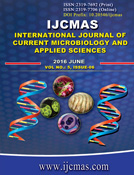


 National Academy of Agricultural Sciences (NAAS)
National Academy of Agricultural Sciences (NAAS)

|
PRINT ISSN : 2319-7692
Online ISSN : 2319-7706 Issues : 12 per year Publisher : Excellent Publishers Email : editorijcmas@gmail.com / submit@ijcmas.com Editor-in-chief: Dr.M.Prakash Index Copernicus ICV 2018: 95.39 NAAS RATING 2020: 5.38 |
This study was conducted in vitro to identify the three plants the ability of a Ceratophyllum demersum and Hydrilla verticellata and Echhornia crassipes to remove the lead element of the sewage using different dilutions (25,50, 100)% of wastewater for a period of thirty days each plant separately and compare the results showed that the three plants have the ability to remove lead from sewage and accumulation in their tissues was C.demersum removes bullets in the leg above the securities while H.verticellata plant accumulates lead in the root <paper <leg while leaf E.crassipes was has the ability to accumulate lead in the root <paper, as compared to the three plants in its ability to remove lead in the E.crassipes interweave appeared leaf ultra removal of lead capacity. The concentration of elements in the tissues in large quantities. And it found significant differences between the parts of the plant at the level of the probability P ≤ 0.05 in most of concentrations studied during the duration of the experiment, recorded significant differences among the three plants.
 |
 |
 |
 |
 |